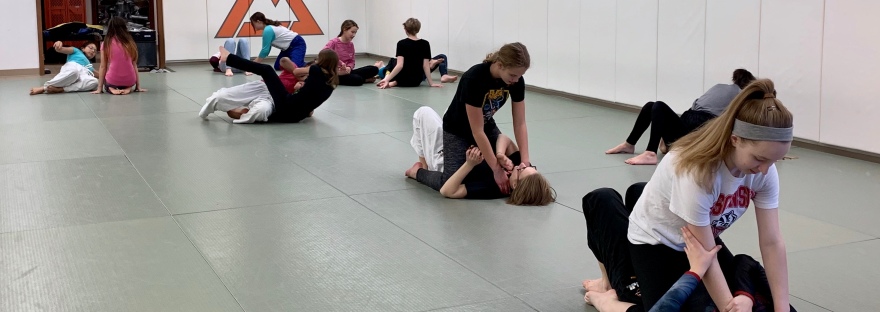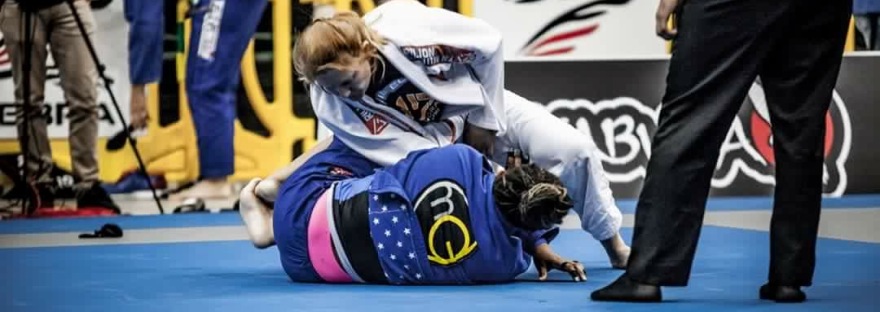Brazilian JiuJitsu is a specialized activity, and it takes some time after diving in to begin to understand what it really is. The difference between a great school and a place that is lacking in one or more ways can be hard for a beginner to judge. By the time a new student figures out that their gym is not a legitimate BJJ school, they may have wasted quite a bit of time and money, opened themselves up to unnecessary injury risk, created bad habits that can hold them back from learning good technique, and developed a false sense of security in their ability to defend themselves. In contrast, a great BJJ school can provide students safe training, physical fitness, solid self-defense skills, and a diverse social group that is supportive and encouraging.
Among the many good BJJ schools, there are differences. Some schools would be classified as self-defense or lifestyle gyms, and some as sport competition gyms, but most are a blend of styles and focus. Each school also attracts a different clientele, has a different atmosphere, training philosophy, schedule, and facilities. How is someone new to the sport able to evaluate the jiujitsu options in their area when they are interested in starting? There are a number of questions you can ask to help you find a legitimate gym that fits you well.
Note: If you are new to jiujitsu, pause here and read my previous blog entry “What is Brazilian JiuJitsu?”. Having more understanding about what BJJ is will allow you to better grasp the need to spend your time training at a real gym that aligns with your interests.
Things to Consider and Questions to Ask
1) The Head Instructor’s credentials. This is the first thing to evaluate, and an easy place to cross the most lacking schools off your list. Do not waste your time learning from someone who is not qualified to lead a school. As jiujitsu has grown and matured, many cities now have schools headed by local black belt instructors. Earning a BJJ black belt generally a takes decade or more of dedicated study and training, and is not awarded lightly. Holding a black belt signifies that a person has studied and practiced long and hard, and their accomplishments have been recognized within the community. A black belt does not necessarily make someone a good person or a great teacher, but if they have attained this rank under a recognized and respected teacher above them, it is probably safe to move on to the next question.
Some newer schools may have brown or possibly even purple belt instructors teaching under an affiliated black belt instructor. Their black belt affiliate will help them progress their own learning, promote their students, and possibly in designing the curriculum. This can be a good situation if the instructor is motivated to continue their own progress, has regular contact with their professor above them, and is good at teaching. Considering a school with a head instructor lower than black belt could be appropriate if there are not other established schools in your area, or if the other local schools have atmospheres or focuses that are not comfortable for you.
One thing to know is that there are unqualified instructors operating schools to teach Brazilian JiuJitsu. It is not uncommon for white or blue belts to open gyms to teach some version of Brazilian JiuJitsu, or self-defense based on BJJ. These schools often use a small curriculum of memorized self-defense responses, and generally do not offer the live sparring that is a critical component of BJJ training. These instructors and their students have no reliable way to improve their skills over time because they are not training with skilled practitioners, and are not receiving live feedback from sparring. These schools take people’s time and money and can’t give much of value back. The instructors at schools such as this often do not have a deep enough understanding of the art to realize how much they do not know, so are unknowingly teaching techniques that are misapplied or in a manner that will not empower a person to use them if needed.
Here are some questions to ask about the head instructor’s credentials. Don’t be shy here—jiujitsu people generally love talking about jiujitsu!
Ask who they have trained under, and who has promoted them to their current belt. They should have a clear answer they are proud of. If they skirt the question or don’t give you a solid name you can look up later, that is a big red flag.
Ask how long they have been training, and if they are a lower belt, how frequently they still work with their affiliated black belt above them. This question is not to determine if your instructor has trained long enough—everyone’s path through the progression of the art is their own. It is to determine if a lower-belt instructor is someone who is well-supported and working to better themselves under an active affiliated black belt. It will also draw your eye to the potential online blue-belt teaching when they are very much beginners themselves.
2) The school’s focus and demographics: Most schools will span a wide group of people and have students with different goals they are hoping to meet through their training. It is not uncommon for teens to be training with 50 year-olds, homeschool moms to be training with construction guys, and serious competitors training with casual students. The diversity of the people in a gym is one of the beautiful things about BJJ, and seeing a variety of people having fun while supporting each other’s differing goals is common at a good gym.
That said, some schools focus more heavily on sport-specific moves and a competition application of the art, and some focus more heavily on moves for a more self-defense style. There is a lot of overlap here—most students will learn the same things over time, and many self-defense schools send people to compete, even if they don’t focus on competition for most of their students.
Questions to ask about the focus and demographics of the gym: Do any of your students compete? The answer should be that at least some students compete sometimes. A school who discourages all students from competing (or visiting other schools) should be a red flag. One of the great things about BJJ is that even casual students can safely compete with others at 100%. A school should be open to receiving feedback about the effectiveness of their students versus students from other gyms.
Are your students expected to compete? It isn’t common that all students at a gym would have to compete to be promoted, but there are some gyms in which competing regularly is expected for many or most of their students. This is not a problem as long as competition is something that you are interested in. Training for competition is often more intense than casual training, and if you are older, have lingering injuries, or differing abilities, serious sport competition schools may be a poor fit for you. If you know that competition will be what you love about BJJ and want to compete frequently, you may want to seek out a competition-focused school with a competitor instructor. Most good schools, however, will be a good fit for both competitors and non-competitors.
When visiting a school to observe or for a trial class, ask yourself if the people you see training in the gym are people you’d like to train with. The most important things to note is the atmosphere created by the people. Don’t judge people by their looks when popping into the gym—judge the gym by how people are interacting. Are they having fun? Are you seeing the more experienced students working respectfully together across lines of size, strength, and sex? Are the people friendly and interested in explaining what you are seeing?
3) Women—The Canaries in the Coal Mine: This article is written for the BJJsisterhood.com blog, so including a section on how women can evaluate a school for their needs is important. Parents evaluating a school for their children and men who want to participate in a safe and supportive atmosphere can also benefit from this information.
When calling to ask questions or when visiting, find out if there are other women who regularly train. A newer or smaller school may just not have their first woman student for no other reason than it just hasn’t happened yet, and you may be that special, gritty one to jump in and blaze the trail. At larger or more mature schools, however, having a number of women who regularly train is a good sign. Fewer women start jiujitsu than men, so the ratio of men-to-women is unlikely to be even, but if a school is having a hard time keeping women as students at a different rate than their men, that is a red flag.
An active group of women in the gym suggests three things, which are indicators of a good school for all students:
A) The instructor matches partners safely and chooses appropriate moves for the pairings that are in each particular class period; keeping in consideration a balance of size, strength, and experience level. This makes for a safer environment for all students, not just women.
B) The instructor values the development of technique and the proper application of jiujitsu moves over simply physically overpowering training partners to “win” as the goal. This encourages the development of quality jiujitsu from all the students, helping everyone to progress more quickly, and builds a safer training environment for everyone.
C) The instructor keeps creeps out, and is not a creep himself. Training Brazilian JiuJitsu requires trust in your partners. Great training does not include dealing with mat bullies, inappropriate touching, or behavior that makes you uncomfortable. A good gym will have many eyes focused on preventing these situations, and the instructor will be very motivated to keep the school a safe place for all students—women, men, and children. If there are a number of women in the gym, that is a good sign that they feel safe and supported
4) Other questions to ask:
Does the school offer classes at a time you can attend? Are there enough classes offered that you could attend two classes per week to start?
Are they upfront about their pricing? Do they have a contract and do you understand it?
When you walk into the school, does it seem clean? Does it smell like a moldy sock? Our gym is generally quite clean, but I have visited some that have not seemed like they are well-tended. Remember that you are going to be touching the mat and it is not uncommon to find yourself face down on it from time-to-time. The locker room area should be comfortable, and people should wear shoes to the bathroom
Steps to Take:
After reading about what Brazilian JiuJitsu is and making your list of questions to find answers to, call or message the local schools you are interested in. Ask if you can come in to try a free class. All schools should allow prospective students to try a class to see if they like the gym and if BJJ is something they are interested in. Stick around after class to watch the students “roll” or spar with each other—this will show you what BJJ really is, and give you the chance to feel out the atmosphere of the gym. See if you can watch the instructor wrestle some of his or her students, and spend some time talking with the people. Get the scoop on membership, fees, schedule, and anything else that interests you.
If you decide to join, set a schedule for yourself. Choose two or three classes each week—I have seen many beginning students make great progress when coming regularly twice a week. Pick an amount of time and commit yourself to going regularly for 6 or 12 months. BJJ is an activity with a steep learning curve at the beginning, and the progress is slow, so a nice chunk of time is necessary to really know what you are doing, where you see yourself going in the art, and if you want to continue.
Good luck, and I hope to see you on the mats!




